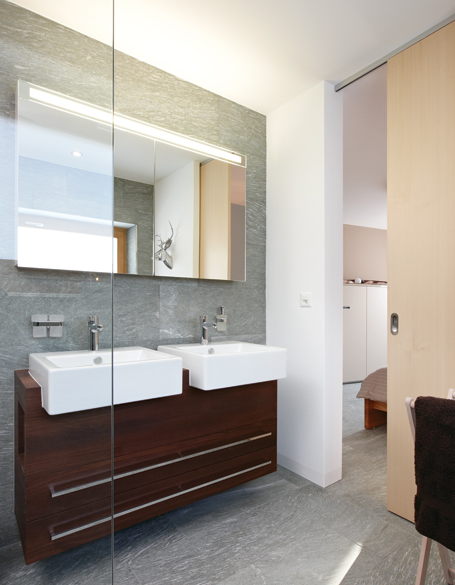Open Sesame: Specifying Top-Hung Sliding Hardware Systems
Straight, folding, and stacking door systems offer innovative uses of space and longstanding, durable operations
![]() Continuing Education
Continuing Education
Use the following learning objectives to focus your study while reading this month’s Continuing Education article.
Learning Objectives - After reading this article, you will be able to:
- Discuss the benefits of top-hung sliding hardware systems for safe, healthy interiors.
- Identify the basic components of a sliding hardware system, and understand the terminology for proper installation and operation.
- Describe the basic system types and application types for top-hung sliding doors and panels, including their benefits for more adaptable, inclusive occupancies.
- Apply the lessons learned to identify the suitable top-hung system for a given architectural need or application to serve the special needs and overall welfare of the building users.
Sliding hardware systems open doors, both literally and figuratively, to creating more flexible, accessible, space-saving interior architecture. Solutions using top-hung sliding hardware are seemingly unlimited, with options including straight-sliding, curving, folding, and stacking configurations for glass, wood, metal, and other panel materials. Applications include sliding doors, movable walls, hardware for furniture as well as sliding shutters.
All of these applications present a range of benefits for the end-user and for architectural design in general. But to tap into these advantages and make the building more user-friendly and adaptable, savvy architects are educating themselves about the various top-hung sliding hardware types, how they work, and how to create the best possible designs and specifications.
Hardware consultants, manufacturers, and fabricators are helping to illuminate this challenge while also demonstrating that good working knowledge of top-hung sliding hardware basics will give the design professional a decided advantage. “Using sliding hardware systems adds new dimensions to a building's design and interior functionality,” says Keith Duckett, national sales director for Hawa Americas Inc. “While the architectural concept starts with considerations about how the moveable elements will function, the key to success is basic, baseline knowledge of how to identify and specify the suitable top-hung system for any given application.”
With that in mind, this educational article offers a brief overview of benefits of top-hung sliding systems, which can help guide their use in architectural projects. Then we consider the basic components of a top-hung sliding hardware system—including the standard terminology and how they work—and look at their use in basic system types and varied, common applications. Last, we present a straightforward, basic method for identifying the suitable top-hung hardware system for a given architectural need or building application.
“The best way to select a system is by considering the architectural objective or function: Are you trying to divide a room, hide a space or storage, frame or block a view, replace a pivoting door or something else?” Duckett asks. “But before you can match that with the most effective or suitable top-hung system, architects need a working understanding of this family of specialty hardware.”

Photo courtesy of Hawa Americas Inc.
For restaurants and hotel areas that need to close off a party space or a section of a foodservice area, sliding doors can match the establishment’s aesthetics and help keep renovation costs low. Panels of custom wood and glass match this interior design.
A History of Sliding Architectural Hardware
Older buildings around the world often have doors that slide on heavy metal tracks, usually flat or angled. These early, top-hung sliding door assemblies, originally developed for use in horse stables, agricultural facilities, and other high-function, low-design exterior openings, were rudimentary and occasionally dangerous. The door hangers—wheel assemblies also called trolleys or trucks usually held by heavy bolts and attached to the wood or metal doors—would at times unseat from the tracks, with calamitous consequences. To prevent such incidents, in the late 1920s architects began specifying enclosed tracks, also called box tracks, which guided the trolleys better and kept occupants safe.
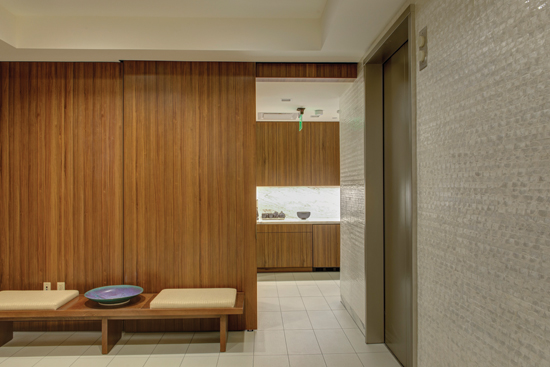
Photo courtesy of Hawa Americas Inc.
Sliding hardware units for full-height sliding doors with dark wood panels appear visually flush to the ceilings thanks to fully concealed tracks.
With a new and safe approach that many manufacturers promoted over the next decades, the popularity of “modern sliding hardware” began to grow. Applications emerged for building interiors—not just in stables and mills but also in schools, office buildings, shops, cultural facilities, and more. Incremental design improvements yielded cleaner, more reliable operations because the tracks did not become a resting place for dirt and dust. The rigid, rectangular steel sections also boosted the weight capacities, leading to more slender, lighter track assemblies.
Interior partitions date back earlier, but they flourished in the modern architecture era of the 1950s and 1960s. Fabricators experimented with lighter steel, aluminum, and other materials for the hardware, and the indoor panels could be made with glass, allowing more light and transparency into building interiors. Industrialization led to a new era of convenience, accessibility, and adaptability in the interiors, thanks to a new generation of sliding hardware systems.
The Systems Approach
For today's architectural applications, sliding hardware can best be considered as a hardware system rather than as assemblies of mix-and-match components. Still, the architect and project team should be familiar with all the essential components, many of which have survived since the era of the primitive sliding barn door. The key terminology includes the track, the trolley, the suspension that connects the trolley to the door or wall panel, and door guides and door stops. (This terminology is described in detail in the section “Reviewing the Basics” on page 4.)
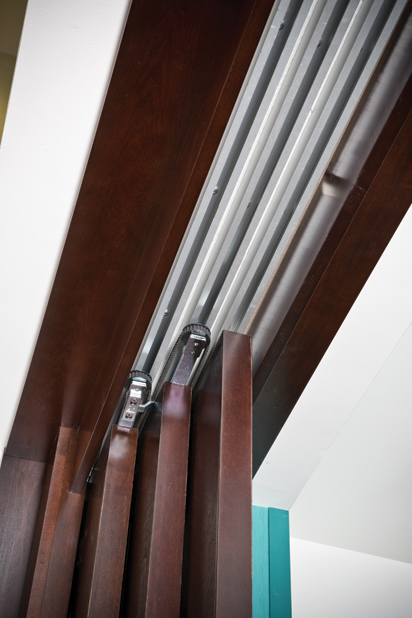
Photo courtesy of Hawa Americas Inc.
Sliding hardware systems include a number of specialized components that work together, including the track, the trolley, the suspension that connects the trolley to the door or wall panel, and door guides and door stops.
Systems approach thinking also helps illuminate the various benefits of today's top-hung sliding hardware systems. The advantages combine both architectural form and function as well as health, efficiency, and sustainability—suggesting a number of pragmatic solutions to creating better interior space. In particular, architects describe the following benefits of sliding hardware systems:
Architectural Interest
By creating more malleable, integrated spatial arrangements, sliding doors enhance architectural function and meaning. Transitions between rooms, between indoors and out, and between protected areas and those dappled with sunlight, can be created with sliding doors due to a threshold condition that can be closed, fully open, or partially open. Moving walls assist daylight control and privacy, too.
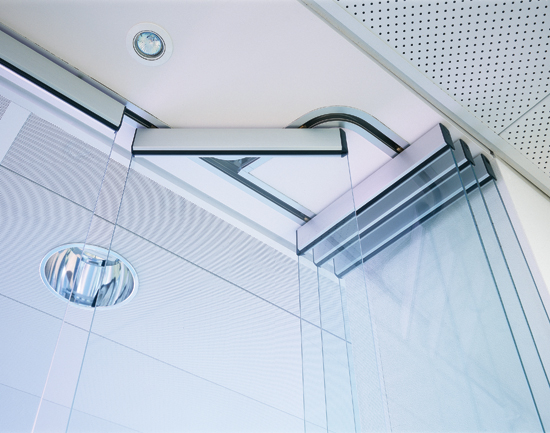
Photo courtesy of Hawa Americas Inc.
For the placement of retracted panels in a large opening, sliding and stacking systems utilize curvilinear track interchanges engineered to smoothly move panels parallel or perpendicular to the opening.
Motion
Architecture that moves is not only functional but it's also dramatic and meaningful. This is especially true with top-hung hardware that moves two bi-parting doors simultaneously; move one door, and the door opposite moves in synch. (These symmetric doors, which some architects call “mirror doors,” are discussed in more detail in the section “Telescoping and Symmetrical Arrangements” on page 5.)
Space Savings
Efficiency of floor plan and interior uses can accrue from a single sliding door or wall panel. The relatively narrow tracks save space. The net effect is to make spaces look larger, especially when transparent panels are used.
Eliminates Door Swing
Also, the sliding door, like a traditional pocket door, needs no space for a swinging leaf or pivoting panel, meaning more floor area is available for programmatic needs. This related benefit is valuable for safety in some circumstances. For interior planning purposes, pivoting doors tend to intrude into occupant room, while sliding panels typically do not.
Cost Savings
Sliding doors and walls save space both in visual and practical terms. This means interior spaces and rooms generally can achieve as much or more while being more efficient in square footage.
Accessibility
Sliding door hardware can be employed to accommodate people with disabilities, such as the mobility impaired. Sliding doors are easy to move and operate with little force, so the door panels move out of the path of travel for people using walkers or wheelchairs. In this way, the sliding door presents no obstruction for most users, and it is an appropriate opening specification that meets the requirements of the Americans with Disabilities Act (ADA).
Flexibility in Division of Space
“Beyond space savings, top-hung sliding doors allow new ways to divide up suites, classrooms, conference centers, and any other buildings that serve multiple functions and constituencies,” says Duckett. A simple linear door can neatly separate a kitchen from a laundry unit, giving it two uses. Many restaurants use top-hung sliding doors to set aside space for private parties, whether intimate or grand. Workplaces and learning environments can “break out” into smaller groups with all the requisite privacy, says Stuart Brodsky, AIA, LEED AP, an associate principal at Cannon Design who has used operable interior glass panels. “This flexibility allows access to shared resources and adapts spaces for small and large groups.”

Photos courtesy of Hawa Americas Inc.
Hardware for pivot/slide-in systems does not require a bottom guide channel to optimize flexibility and utilization, allowing for “hidden offices” and kitchenette storage and leaving an uncluttered look in the space.
Safety
In addition to easing movement between interior areas, sliding doors can reduce the collisions or disruptions of egress associated with traditional pivot doors. (Ever wonder why vision panels are specified in so many swinging doors?) Sliding doors ease the transition, and open the area for occupant movement.
Renovation Uses
Several benefits specific to top-hung sliding door hardware systems improve the success of renovation projects. First, compare them to bottom-rolling sliding systems that carry the weight of the door panels on the floor: In these cases, uneven or bumpy floors with material transitions must be corrected and completely leveled for the bottom-rolling hardware to work properly. Floor condition in a renovated building becomes critical. But this is less so for top-hung systems, which can tolerate some variations in floor level, conditions, and materials, such as a transition from high-pile carpet to tile or stone.
Clean Floor Plane
A related benefit is the visually clean and uncluttered floor expanse allowed with top-hung systems. The bottom-rolling types require a threshold or track on the floor—which not incidentally is also a physical obstacle and impediment, not just a visual obstruction. Top-hung sliding systems may eliminate the thresholds and floor tracks.
Clean Door, Jambs, and Ceiling
Above eye level, top-hung sliding hardware is easier to conceal than bottom-rollers and other opening systems. No door-jamb header is needed, and the track can be recessed into the ceiling.
Allowing spaces to be rearranged effortlessly and cleaning up the details of the interior—while also allowing for safer and more functional use—are perhaps the most essential reasons to use top-hung sliding hardware. With more interest in multifunctional interiors as well as indoor-outdoor architecture, sliding doors take many residential and commercial applications to new heights of efficiency and visual interest. It's no exaggeration to say that sliding door hardware can be considered integral to a building's environmental and design strategy.
Understanding the numerous ins and outs of sliding hardware systems—from materials to mounting, and from trolley to track—will help architects not only take advantage of these numerous benefits but also create better experiences for building owners and occupants.
Reviewing the Basics
To identify the components of the sliding door hardware systems, one can start with the historical fundamentals and expand from there, adding the new elements introduced in more recent engineering and manufacturing advances. For architects, the following are most important in the design and specification of a project leveraging top-hung sliding hardware:
Track
Sliding door tracks come in different shapes (sections) that offer varied benefits and lend themselves to certain applications. Box type track, mentioned earlier, holds the door securely and is less prone to contamination than others. By eliminating the potential for trolleys to “jump the track” and because they are easier to keep clean than other types, box sections are generally a solid, economical specification for any need.
Compare this to the I-beam track, on which dual trolleys are set on both sides of the I-section, and the C-shaped track, which may have a raised lip on which the shaped trolley rests. The light I-beam, typically of extruded aluminum, recalls their zinc-plated steel cousins used for heavy-duty agricultural uses, with the exposed trolleys imparting an industrial feel. The C-shaped track extrusions are readily adapted to shapes and curves, letting designers create sliding doors that bend, arc, and even turn corners.
Tracks are mounted above in a manner depending on the selected section, door need, and architectural assembly. Track mounting options for top-hung hardware systems include side mount assemblies fixed to a wall, soffit edge, or other vertical surface structure as compared to ceiling surface mount, where the hardware assembly extends down from the horizontal plane. Ceiling recessed mount is a third attachment option, in which the track is buried up and within the ceiling plane, lending a clean and visually unobtrusive condition.
Trolleys
Also known as the carrier, the trolley is a wheeled carriage device that travels along the overhead track. Considerations for the trolley hardware should reflect the mounting approach, the weight of the door, and whether the track has curves or corners. All of these will affect the bearing weight on the rolling hardware, to be calculated by the engineer or architect. For this reason, trolley designs vary quite a bit.
Suspension System
The suspension system links the trolley to the top of the wall or door panel in a top-hung configuration. The suspension hardware is often surface mounted and therefore visible; however the suspension can also be neatly concealed within the door itself. The latter option, often called buried suspension as well as concealed or hidden suspension, is attractive and suitable for carefully detailed, high-end interiors.
Door Guides
These are used to keep door or wall panels moving in line with their overhead tracks and to prevent them from swinging. Guides may be attached to the floor or wall (or both), eliminating the need for any modifications to the floor and thus providing a barrier-free threshold. Compare this to a continuous floor guide, which is required for very heavy sliding panels, wide panels, or panels that are designed to slide farther than their own width.
Unlike the raised continuous floor track typical of inexpensive residential-type sliding screens and patio doors, for today's top-hung sliding hardware systems the continuous floor guide can be a clean, narrow slot opening recessed into the floor materials. Again, it requires no raised threshold, and the door slides in a solid manner with no sway. Architects and contractors should plan to use a continuous floor guide whenever:
• Door or wall panels are heavy and require control.
• Any panel slides more than its own width.
• A panel's height-to-width ratio is too large to avoid sway at the unguided end.
• Any panel widths exceed 5 feet.
Door Stops
Another key piece of hardware built for top-hung and other sliding systems is the door stop, which can be exposed or concealed and serves to ensure the door or wall panel never slides beyond its intended reach. The track stop is inserted inside the track, hidden from view but providing for function and safety all the while. Alternatively a bottom door stop is a visible, floor- or wall-mounted component that limits the endpoint of a slide run. A standard “door stop” called out in specs is assumed to be the wall-mounted version, analogous to a stop used for a pivot or swing door. Materials of the stops should match the hardware, with metals such as stainless steel and hard rubber head elements or collars.
In addition to these five hardware components—track, trolley, suspension, guides, and stops—there are many other elements and options that may be considered depending on functionality and aesthetic expression. Panel materials, for example, may include wood, glass, metal, and a combination of these as well as a number of any of the above composite panels and manufactured materials, such as structural colored and shaped acrylic panels. But the basics of top-hung sliding design requires the designer to be familiar with and work with the core five hardware components to design and deploy a successful sliding system.
Primary Systems and Applications
Perhaps the architect has heard the terms—pocket door or sliding bypass—or perhaps the terms multi-slide and multi-fold are unfamiliar. Whether or not one uses the terms, designers can apply these valuable concepts to the schematic and design development phases to make their building environments more functional, efficient, and experiential. So what are basic system types and application types?
The first consideration is architectural need and function. For example, is the requirement a door opening where sliding hardware affords various advantages? If it's conceived as a moveable wall, does the sliding system fold or stack? Another common use is for furniture, where the casework or storage areas can be hidden behind translucent or opaque panels. And for the exterior envelope, can matching outdoor shutters enhance building function?
A second consideration is that applications have a lot to do with how the panels move. Do they only move in a straight line, or do they curve? Just one panel that slides straight, or multiple door panels? If multiple, are they in the same track or in multiple tracks?
Third, consider the hardware system: Why would top-hung or bottom-supported systems be more suitable, durable, and effective? For the top-hung types, the weight of the panels and frames are supported by top track. Bottom rolling systems use the track at the floor or base to support the panels' weight and allow for movement.
Characteristics of top-hung versus bottom-rolling systems, in addition to those mentioned previously, are worth discussion during project design development. For top-hung systems, a recessed and concealed top track above the ceiling plane is possible. The top-hung products generally require less force to move the panels, and the trolleys remain in continuous contact with the tracks. A wide range of curvilinear movements and curved panels can be used. At the floor plane, the finished look imparts clean continuity: It allows for a clear threshold, and it's easier to deal with unlevel floor conditions.
Bottom-rolling systems have a few clear advantages. The main one is that the systems can achieve very high load capacities using relatively simple hardware. However these bottom-rollers require a bottom track, surface-mounted or mortised into the floor that must be as level as possible. On the downside, bottom-rolling hardware is prone to malfunction where the rolling elements, or sheaves, jump the tracks. Installation may be complicated by any uneven floor surfaces; in terms of operation, the presence of the track in the doorway can limit uses, and the bottom track can collect dirt and debris, impairing door movement over time.
Using selections from the above key criteria—function, movement options, and hardware type—the architect can determine the most effective configurations for the openings. Common arrangements of the sliding doors and panels include the two most basic: linear (straight path) and curvilinear (radius path) sliding systems. A single-panel, single-track assembly is the most basic linear design, while a bi-parting system uses two single panels sliding on a single track. Add a second track, and the design can accommodate a bi-directional, bi-passing configuration with two or more tracks and two or more panels that can move past each other as needed.
Sliding Wall Systems
There are two basic types of sliding wall systems: First is the sliding-and-stacking type, and second is the sliding-and-folding type. Each has its own benefits for certain situations, depending on the space allowed and end-user preferences. Understanding the mechanics and geometries of each type will help savvy architects select the most suitable and convenient door system.
For placement of retracted panels in a large opening, sliding and stacking systems utilize curvilinear track interchanges. These tracks are engineered to smoothly move and stack the panels either parallel or perpendicular to the tracks within the openings, in efficient alcoves or recessed niches often called “parking areas” in the industry. The interchanges and parking areas allow for quiet and relatively effortless maneuvering of panels into the stacking area and, if needed, by changing their direction and orientation. These systems have been used by architects and building owners to add extensive flexibility to interior environments.
In typical stacking systems, the panels operate independently and are not connected to each other. This increases the amount of movement allowed for each panel; they can slide farther and carry more weight. It also increases the flexibility of how the panels work together. When in “parked” or stacked position, they can be placed in a position parallel or perpendicular to the main track.
Unlike stacking systems, folding hardware systems feature panels that are hinged together. These allow for a large opening while the panels are moved into an open or retracted position. These systems can be specified as either center-hung—with no continuous floor channel guide needed because the panel arrangement is balanced—or edge-hung, which requires a floor guide, but does not require a half panel as in center-hung configurations.
Telescoping and Symmetrical Arrangements
The special cases of three unique types of top-hung sliding hardware systems—with the potential for unique parking area abilities and user benefits—merit a detailed review.
The first, the telescopic type of system, allows two or more panels to be moved simultaneously to the right or to the left, or both. A practical advantage of this system type is that the set of sliding panels or doors can measure, for example, twice as wide as a recess in which it is parked. So given a small pocket wall or wall segment, the designer can use the telescoping system to emerge and enclose a much larger opening with glass or wood. These systems are ideal for tight quarters in a variety of facilities, and by using glass panels they can make the spaces feel larger even when enclosed. Anywhere there is an opening larger than available panel parking area, telescoping hardware systems may be suitable.
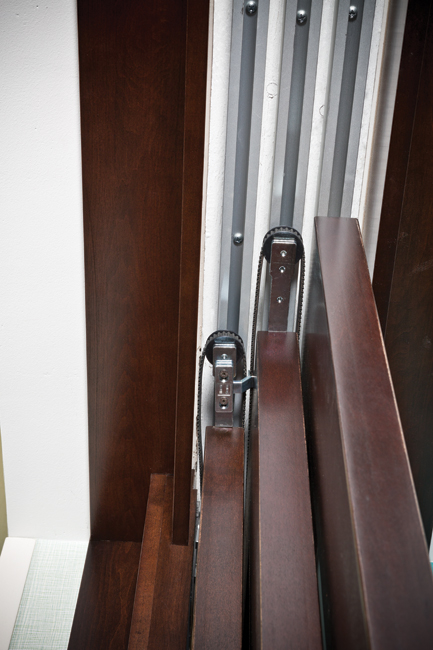
Photo courtesy of Hawa Americas Inc.
A close-up of the telescopic type of sliding system, which allows two or more panels to be moved simultaneously to the right or to the left, or both. This allows a set of sliding panels or doors to fit in a very small recess relative to the opening width.
The second type of top-hung hardware may be informally called a mirror arrangement but is best known as a symmetrical or “symmetric” hardware. This type allows for the simultaneous opening and closing of two separate bi-parting panels or doors opposite each other, creating the appearance of a reflected or mirror effect. For user convenience, both panels open or close at the same time by simply operating either the panel on the left or the right.
Last, the third kind of hardware technology can be called a pivot/slide-in system, sometimes known as a scissor system. Seen often on wood cabinet and partition doors where the panel pivots and then slide back to a recessed position, these systems can also serve room-height doors and wall panels. The hardware does not require a bottom guide channel to optimize flexibility and utilization, but the design must allow for sufficient depth of the parking slot as well as the correct location for the fitting mounts. The hardware has been used to create “hidden offices” and storage in spaces where the occupants desire an uncluttered look while maintaining requisite function. As one Swiss manufacturer famously explained, “Everything not in use will vanish!”
Top-Hung Applications, Seen and Unseen
Vanishing spaces, hidden doors, concealed hardware, and transparent glass panels—clearly, the benefits of top-hung sliding hardware systems are as much about what one doesn't see as what one does see. For this reason, many architects have come to understand sliding doors as a stealth benefit of their design concepts, adding functionality without furnishings and increasing drama without clutter.
The first question in the schematic design phase is, “How do we want the space to function and, where we have sliding door systems, what do we want those openings to do?” Another key planning consideration is the precise location and orientation of the door or wall panels, both in their deployed and retracted positions. These questions should be answered by the design team and client in order to identify and select the suitable sliding system for a given application. Experts in sliding hardware systems recommend the following five-question approach:
1. What's the function? This is simply the objective of the use, but it should also answer what the users or occupants expect the system to do—for example, hide a space, block a view, divide a room, replace a pivoting door, or another objective.
2. How should the doors or panels move? As discussed previously, it's not just a straight line or curve. Should they also stack, telescope, or open in unison?
3. How large is the opening? Ensure that any contents will fit through the allotted width, and that any egress allowances or other code-mandated minimum dimensions are met. Then consider the implications of comfort and practical use.
4. How is the hardware configured? The first question for sliding hardware is, where should it be mounted? Second, is it concealed or exposed—and will that work with the proposed location? Third, examine any code, design, and installation impacts of these choices.
5. What materials should be used? This covers the concealed and exposed hardware as well as the panels and their parking areas, in some cases. Look for finishes and colors that support the overall composition. Consider how function might expand the palette: Transparent and translucent panels may provide more benefits than opaque materials, for example.
As an example, consider the Chicago restaurant that needed the option to close off a party space by dividing a room that was nominally 10 feet wide. To match the establishment's aesthetics, keep renovation costs low, and provide for accessible hardware, the architects recommended the track be surface mounted. The panels of custom wood with a natural grain finish would deploy and stay motionless, suggesting a paneled wall matching its old-school, steakhouse atmosphere. When not in use, the panels would fold like an accordion to open the space, in less than a minute, with only modest effort on the part of the restaurant staff.
In this case the architects answered all five of the basic questions in order to provide a schematic design concept to the client and a sliding system specialty contractor. With input from each party, the design process could proceed with confidence.
Specifying a Detailed Sliding System
In addition to this basic approach to schematic design, a number of key details and engineering considerations must be answered for any top-hung sliding hardware system. Among those are the door weight, the number of panels, installation methods, door movement and placement, and suitable hardware selections.
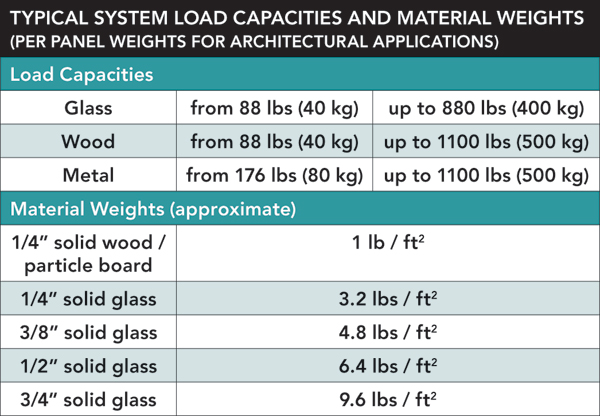
Image courtesy of Hawa Americas Inc.
Door Weight
To understand the feasibility of the system and design concept, the project team should determine door or panel weight based on the panel materials and size—thickness as well as width by height dimensions.
Number of Panels
Both design intent and opening size influence the panel configurations for a sliding hardware system. Consultation with a manufacturer, door hardware consultant, or a seasoned installer will help confirm the most cost-effective and highest-functioning panel combination.
Installation Methods
Compare the benefits of ceiling-mounted versus side-mounted (wall-mounted) systems, as described above, and the benefits of recessing the top-hung hardware within the ceiling assembly.
Door Movement and Placement
The top-hung assemblies offer many movement options. They can be synchronized or independently operated, they may follow a straight path or curvilinear track system, and they may offer sliding and stacking operations. Door placement can include pocket designs, side-mounting on a wall, and they may include one or more stationary panels. Consider these options as a kit-of-parts, and review the optimal motions and orientations for the given use.
Hardware System Design
The tracks, trolleys, and suspension can be specified as a concealed hardware system or an exposed system with or without a fascia. The concealed look is sleek, minimal, and professional. A wall-mounted track can be left exposed for an industrial or loft-style feel, or it can be given a more finished look with an architectural fascia of wood or another matching material.
With these considerations and a specific architectural concept in mind, the architectural team is close to its goal of an effective top-hung sliding hardware selection.
Quality, Design, and Performance
As with any architectural assembly or engineered system, the quality of the products used should be considered in the selection and specification of sliding hardware. Durability and life-cycle performance are just as essential as purchased cost: When the architectural element moves, performance is considered based on how many cycles of use the system can tolerate over years and years of operation.
In terms of material performance, consider machined and cast hardware components versus the stamped sheet-metal products now on the market. Good systems tend to have tighter dimensional tolerances—the mark of well-controlled fabrication processes. Some architects specify ISO 9000 or similar third-party certifications for their manufacturers, another yardstick for control of their processes. Ask the sales representative whether the maker uses automated assembly technology, which often makes a more consistent product than manual assembly plants.
As for the component products, they are essential to the reliability of the system overall. If the manufacturer offers a track record of good performance and can document more frequent testing, suppliers have more confidence in their products. Labeling and documentation should indicate conformance to relevant benchmarks and standards, and the product should meet the requirements of jurisdictional codes and ADA guidelines. Last, the installer should be reputable and experienced. There's nothing worse than seeing a good product installed poorly by inexperienced trades that never got training from the manufacturer.
In general, the market for top-hung sliding hardware systems is competitive and reliable, thanks in part to a tradition of European engineering and manufacturing. Specified properly, these sliding systems add new dimensions to a building's design and interior functionality. The first step is to consider how the moveable elements will work, and to identify the correct solutions and applications to make the concept as user-friendly and adaptable as possible.
 |
| Hawa Americas Inc. is the U.S. subsidiary of Hawa AG, a Swiss manufacturer of precision sliding hardware systems. Hawa has been manufacturing high-quality sliding hardware for doors, walls, furniture, and exterior shutters for 50 years. Applications include sliding, folding, and stacking systems designed for use with wood, glass, or metal doors. www.hawa.com |

